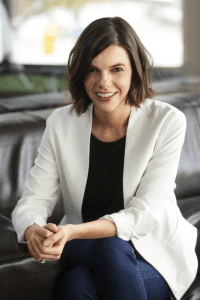[vc_row full_width=”stretch_row” full_height=”yes” parallax=”content-moving” parallax_image=”14501″ parallax_speed_bg=”1.3″][vc_column][vc_empty_space height=”400px”][/vc_column][/vc_row][vc_row][vc_column][vc_column_text]
Photography by Alex Earl Gray
In our Capital Gains series, we spoke to five incredible women on how to raise investment capital, building a brand, and the crucial lessons they’ve learned along the way. Click here to read more stories.
[/vc_column_text][vc_custom_heading text=”When Noura Sakkijha and Majed Masad relaunched their Toronto-based fashion start-up, Mejuri, with a direct-to-consumer model in January 2015, the goal was to bring innovation to the traditional fine jewellery market.” font_container=”tag:h2|font_size:25|text_align:left|color:%23010ea0″][vc_row_inner][vc_column_inner width=”1/2″][vc_single_image image=”14507″ img_size=”full” onclick=”link_image” css_animation=”fadeIn”][/vc_column_inner][vc_column_inner width=”1/2″][vc_column_text]“Part of what [Mejuri] is doing [is] redefining luxury…and really changing the purchasing behaviour for fine jewellery,” says Sakkijha, who hails from Jordan and completed an MBA at Ryerson University, and is a third-generation jeweller.
Thanks to supply chain efficiencies and a noticeably lower mark-up, Mejuri is able to offer fine, responsibly-produced jewelry at price points starting under $100. “We’re able to introduce amazing products from top manufacturers at a fraction of the price,” says Sakkijha. “But we also wanted to position Mejuri [towards] women buying for themselves, as opposed to targeting gifting product.”[/vc_column_text][/vc_column_inner][/vc_row_inner][vc_column_text]Mejuri’s focus on accessibly-priced, everyday fine jewellery marketed specifically to women has resonated with consumers worldwide, and helped the company grow 400 percent year-over-year since 2015. Today, the e-commerce player ships to 35 countries, has a 60,000-plus wait list for product drops, and employs 130 people—80 percent of whom are women—in three countries.
This phenomenal, sustained growth was possible, in part, thanks to Sakkijha’s strategic fundraising efforts. “Since the beginning, we wanted to [build our company] on the VC fast track,” recalls Sakkijha. “We actually launched out of a business-accelerator program in Montreal called FounderFuel, which is part of Real Ventures.” After completing the FounderFuel intensive, Mejuri joined 500 Startups’ prestigious accelerator program in San Francisco, securing seed funding for the business through the process. “Bringing in investors is not just for money, but it’s also strategic in terms of expertise, opening doors, building a great network and backing the company to go at a high speed,” says Sakkijha. [/vc_column_text][vc_row_inner][vc_column_inner width=”2/3″][vc_column_text]“For my seed, it was a very tough process for sure because I was just starting the whole thing; I had no network,” says Sakkijha. “What helped me was being in 500 Startups and getting a lot of introductions. I think it’s important to think outside of your area, and really look at the right investors in North America—don’t limit yourself geographically.” Sakkijha credits the accelerator programs for their help with networking, and setting the company up for success in the fundraising process, but notes that it’s still possible to raise without being in a program. “It’s just about finding people, talking to them, connecting, taking chances, taking meetings, being okay with lots of no’s in the beginning.”[/vc_column_text][/vc_column_inner][vc_column_inner width=”1/3″][vc_single_image image=”14505″ img_size=”full” onclick=”link_image”][/vc_column_inner][/vc_row_inner][vc_row_inner][vc_column_inner][vc_column_text]In September 2018, Mejuri raised USD $5 million in a Series A led by London’s Felix Capital, and this spring, the company just closed on a USD $23 million Series B round, led by New Enterprise Associates (NEA) with Imaginary, Felix Capital, BDC Capital, Incite Ventures, and Dash Ventures participating.
The latest round of funding was completed while Sakkijha was on bed rest with preeclampsia, seven months pregnant with twins. She took video calls with investors while Masad, her husband and Mejuri’s COO, attended the meetings in person. But, despite these logistical challenges, Sakkijha found the fundraising process easier for Series B in some ways. [/vc_column_text][/vc_column_inner][/vc_row_inner][vc_custom_heading text=”“As the company progresses from one stage to another, it becomes less about proving your existence as a company, but more about your metrics,” explains Sakkijha.” font_container=”tag:h2|font_size:28|text_align:left|color:%23010ea0″][vc_row_inner][vc_column_inner width=”1/2″][vc_empty_space height=”30px”][vc_single_image image=”14508″ img_size=”full” onclick=”link_image”][/vc_column_inner][vc_column_inner width=”1/2″][vc_column_text]“We’ve had solid metrics that we can go and present to our prospective investors.” The company’s existing relationships and network, too, helped. “Our investors before Series B are very strong, they have a great network, and they’ve opened up a lot of doors and conversations for us, so it was easier in that sense. And our numbers were also a lot more advanced than they were before,” says Sakkijha.
Having gone through three successful rounds of fundraising, the CEO emphasizes the importance of fit when it comes to choosing the right investors. “As you become larger, you tend to know the levers of the business and you don’t necessarily always need to raise money—you’re raising money for more reasons than just the capital,” says Sakkijha. “Capital is important, but you’re also looking to bring the right partners on board, who can weigh in on tough decisions or strategic decisions, and can open up doors.” [/vc_column_text][/vc_column_inner][/vc_row_inner][vc_separator color=”black” border_width=”3″][vc_column_text]
In our Capital Gains series, we spoke to five incredible women on how to raise investment capital, building a brand, and the crucial lessons they’ve learned along the way. Click here to read more stories.
[/vc_column_text][/vc_column][/vc_row]













